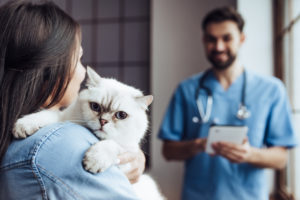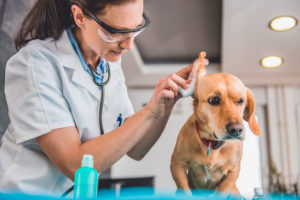
Advances in animal behavior have helped veterinarians provide less stressful care to many patients, both large and small. The ability to correctly read the body language of stress before it reaches aggression, and then respond to this by changing the exam room, treatment, and hospitalization areas has helped keep staff safe and prevented aggression.[1] There are some cases, though, where reducing the environmental stress is not enough.
When you are presented with a patient that is increasing in anxiety to the point of aggressing despite changing your approach or using rewards, appropriate anxiety-reducing medication is needed for improved patient welfare.[2] The advancing knowledge of both animal behavior and pain management has provided veterinarians a broad base of medications to use in these cases. Pre-visit pharmaceuticals (PVP) are given to create a less anxious and easier to handle animal. Medication does not reduce the need for less stressful handling or providing a less stressful environment. Medications are tools to prevent the damaging effects of stress: increased heart rate, struggle that can lead to injury, and retaining a memory of fear associated with the veterinary practice.
Prior to the advancement of less stressful veterinary care, the use of pre-visit medications was limited to strong oral sedatives such as Acepromazine. Acepromazine is one of the few oral sedatives approved for veterinary use. Currently, recommendations advise for more anxiolytic medications such as Trazadone, Gabapentin, Alprazolam, and Clonidine. An important point is that these medications are not veterinary approved and are off-label use.[3] There are few, if any, documented studies of how any of these drugs affect behavior.[4] Knowledge and recommendations to use these medications is based upon the personal clinical experience of veterinarians in the field.
Client resistance to pre-visit medications can come from different points of view. Many clients have been prescribed the same drugs we are prescribing for their pet. If the client did not like how the medication made themselves feel, they will naturally be concerned that their pet will have the same experience. Asking a client to sign a waiver for an off-label drug is concerning. Some clients do not want their pet to be affected for hours, when the need for the medication is for a 15-minute appointment.
Take the time to ask the client why they are not agreeing to the needed medication. Listen more than you speak. Many of the client’s concerns are valid, and this creates an opportunity for you to creatively work with your client. Strike a deal with the client and say, “you don’t want drugs, we need a calm, safe pet. Here is what we need you to do to help us,” and then you demonstrate how feeding rewards through a muzzle for dogs (who have been on a 12 hour fast) will help prevent the dog from biting. Explain how the dog will be offered the yummiest food when handling during the most difficult part of the exam. Tell the client this will result in happy visits to the clinic on a regular basis. And then, schedule exams when it is best for the pet, not the owner.
As my friend Dr. Esther Ling of Crest Hill Cat and Dog Clinic in Joliet, IL, says, “the owner is always part of the equation.” For my drug resistant clients, a typical exam would be scheduled as the first one in the morning, on a Wednesday when we were quiet. The animal would be given a bandana with Adaptil or Feliway 30 minutes before travel, and then escorted to the exam room immediately from the car. During the exam the most awesome food would be fed through a muzzle or under a blanket cover. Our cats were examined in the carrier base, using the cowl technique with minimal handling. The deal was three short-and-sweet appointments per year, not just one big appointment, so we could keep it low stress. With each visit, the animal was less stressed and drug free.
There will be times that a medication is needed for patient welfare and safety. The speed of aggression or panic may make this animal unsafe to examine, and the adrenaline/cortisone stress is harmful to the patient’s health. If your client is resistant to pre-exam pharmaceuticals, start with pheromone application before arrival at the clinic. This gives a baseline anxiolytic effect and is often accepted by clients. Give oral transmucosal Buprenorphine to relieve any possible pain at history taking. Emphasize the pain relief requirement to provide a kind and accurate exam. Buprenorphine does not sedate and be sure to inform your client of this as it reduces the client resistance and will begin to show clinical benefit in a few minutes. Apply topical anesthetic to injection sites ahead of time and inform the client you are doing this to reduce pain and anxiety from pain. With every approach and touch, tell the client what you see in the animal’s response. This is how you educate your client about both your efforts to reduce stress and to recognize the body language of stress in our patients. Following these steps, 85% of my patients would reduce their anxiety and aggression without medication. The remaining 15% needed medication or supplements to provide mental calm. The verbalization of what we saw, and the client witnessing our adaptation to the patient to reduce stress, helped our clients understand why medication or supplements were needed for care.
Many of my clients were drug resistant. Why? It may be the rural, small town conservative approach to life here in Tuscola, IL, where I live. Many farmers had toughed out injuries – “so why can’t my animal tough it out?” they would say. I found supplements were accepted by clients and were effective to reduce anxiety and mild aggression when combined with a Low Stress Handling® plan. The supplement did not have some of the side effects such as aggression disinhibition. Over 30 years of practice at my clinic I did not have a “back” so the majority of blood draw, care, and treatment was performed in the exam room with the client present. This approach kept care transparent. If the pet was resistant it was clearer to the client that drugs were needed and were then accepted.
Where would I draw the line on the drug resistant client?
When either patient safety or staff safety was at risk. If a dog or cat was struggling, urinating, or cowering despite using less stressful veterinary care I would stop, and I required my staff to do the same. I would point out how this experience was harming the heart, the joints, and creating a firm memory to panic or aggression. If the client would not accept the need for medication, then I would refuse care. I often quoted the $350,000.00 average educational cost to create a DVM,[5] or $50,000.00 cost to create a licensed tech, and that my practice could not afford to lose either. At this point, many clients agreed to use the medications. For those who did not I referred them to a house call veterinarian and then informed that veterinarian of this patient’s triggers to stress and behavior.
We cannot force our clients to take our recommendations. We can ask why they are resistant and listen. Think of ways to address the fears. If the client is afraid of how the medication will affect the pet, offer day-care and give the trial dose at the clinic. You can observe the response, take a video to show the client and you may be able to provide the care that day as well. Know your drugs and how effective they are for modifying specific behaviors. Trazadone is a popular drug to reduce physical activity, yet it is not a sedative. It will not be enough as a solo agent to prevent a dog from lunging up to bite you. Alprazolam will help reduce fear but may disinhibit aggression.[6] Tell the client why you have chosen a certain medication, and what to expect as the response. Empathize with clients that worry their pet will feel as weird as they did on a medication. Discuss the differences in animal metabolism as compared to human. In the end, my negotiation was the less medication, the more I needed the client to co-operate by bringing a prepared patient, scheduling when it was best for the pet not the human, and follow all the steps of the plan we created for care. We should not use medications to replace expansion of our low stress handing knowledge. Creative, empathetic use of both less stressful care and appropriate medications can help reduce a client’s resistance to their use.
For more information and products from Low Stress Handling® visit our store, or sign up for our online course.
- Foote, S. Job stress of veterinary staff in small animal practice. JAVTE Summer, 2019. p. 4-9.
- Lloyd, J. Minimizing Stress for Patients in the Veterinary Hospital: Why It Is Important and What Can Be Done about It. Vet Sci. 2017 Jun; 4(2): 22. Published online Apr. 13, 2017. doi: 10.3390/vetsci4020022
- FDA.gov, Approved animal drug products. https://animaldrugsatfda.fda.gov/adafda/views/#/search. Accessed Sept. 12, 2019
- Shell, L. Psychotropic Agents. https://www.merckvetmanual.com/pharmacology/systemic-pharmacotherapeutics-of-the-nervous-system/psychotropic-agents. Accessed Sept.12, 2019.
- AAVMC.org. AAVMC cost comparison tool. https://www.aavmc.org/students-applicants-and-advisors/exploring-the-cost-of-a-veterinary-medical-education.aspx. Accessed Sept.12, 2019.
- Albrecht, B., Staiger, P., Hall, K. Benzodiazepine use and aggressive behaviour: A systematic review. https://journals.sagepub.com/doi/abs/10.1177/0004867414548902. Accessed Sept 12, 2019.





